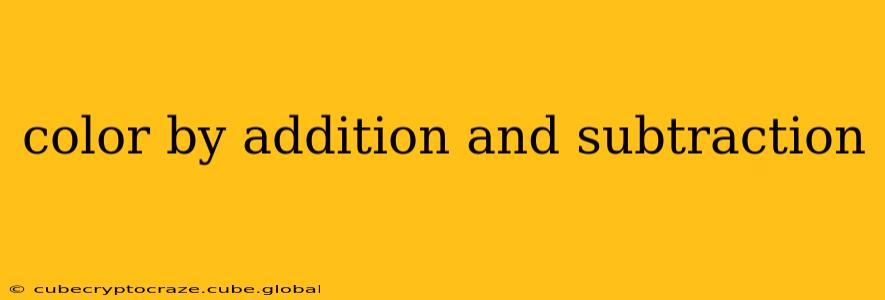Understanding how colors interact is fundamental to any creative field, from painting and graphic design to photography and even culinary arts. This exploration delves into the fascinating worlds of color addition and subtraction, explaining the principles behind these processes and how they impact the final visual result. We'll unravel the mysteries of how light and pigment combine to create the vibrant spectrum of colors we see.
What is Color Addition?
Color addition, also known as additive color mixing, is the process of mixing colored lights. This is the system used in screens, projectors, and other light-emitting devices. The primary colors in additive mixing are red, green, and blue (RGB). When these three colors are combined at full intensity, they create white light. This is because they stimulate all the color receptors in our eyes equally.
How Does Additive Color Mixing Work?
Imagine shining a red light and a green light on a white surface. Where they overlap, you'll see yellow. Combine red and blue, and you get magenta. Green and blue create cyan. This is because each color adds its wavelengths to the mix. The more colors you add, the closer you get to white.
What are Some Examples of Additive Color Mixing in Action?
- Computer monitors and televisions: These use tiny red, green, and blue pixels to create the images we see.
- Stage lighting: Lighting designers use RGB spotlights to create a wide range of colors and effects.
- Digital photography: Cameras capture light information using RGB sensors.
What is Color Subtraction?
Color subtraction, or subtractive color mixing, involves mixing pigments, such as paints, inks, or dyes. The primary colors in subtractive mixing are cyan, magenta, and yellow (CMY). These colors are chosen because they are the complements of the additive primary colors. When you mix cyan, magenta, and yellow pigments together, you theoretically get black. However, in practice, this often results in a muddy brown, so black is often added to the CMY model creating CMYK (K standing for Key, or black).
How Does Subtractive Color Mixing Work?
Unlike additive mixing, where colors combine to create brighter hues, subtractive mixing works by absorbing certain wavelengths of light. For example, cyan pigment absorbs red light and reflects green and blue. When you mix cyan and magenta, you’re absorbing both red and green light, leaving only blue reflected back to your eye.
What are Some Examples of Subtractive Color Mixing in Action?
- Painting: Artists use subtractive color mixing to create a vast range of colors on canvas.
- Printing: Printing processes like CMYK use inks to create images on paper.
- Dyeing fabrics: Fabric dyes work through subtractive color mixing to create various shades and patterns.
What is the Difference Between Additive and Subtractive Color Mixing?
The key difference lies in the medium: additive mixing deals with light, while subtractive mixing deals with pigments. Additive mixing combines light, resulting in increasingly brighter colors culminating in white. Subtractive mixing absorbs light, leading to progressively darker colors culminating in black (or a dark brown in the case of CMY). Understanding this distinction is crucial for achieving desired color results in various artistic and technological applications.
Why is Understanding Color Addition and Subtraction Important?
A solid understanding of additive and subtractive color mixing is essential for anyone working with color. Whether you're designing a website, painting a masterpiece, or simply trying to mix the perfect shade of paint for your home, this knowledge allows for greater precision and control over your color choices. It opens up a world of creative possibilities and helps avoid unexpected color surprises.
How Can I Learn More About Color Theory?
Numerous resources exist for those seeking a deeper understanding of color theory. Books, online courses, and workshops offer comprehensive guides to color mixing and color psychology. Exploring these resources can enhance your creative skills significantly.
This detailed exploration covers the basics of additive and subtractive color mixing. Mastering these concepts is crucial for success in any visually-oriented field. Remember, practice is key! Experiment with different color combinations and observe the results to refine your understanding.
